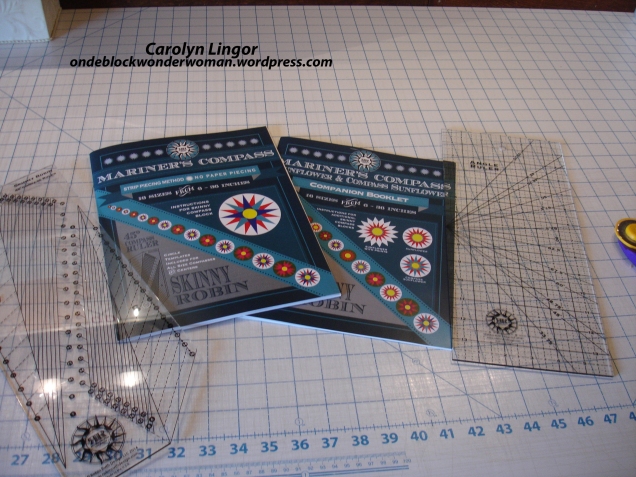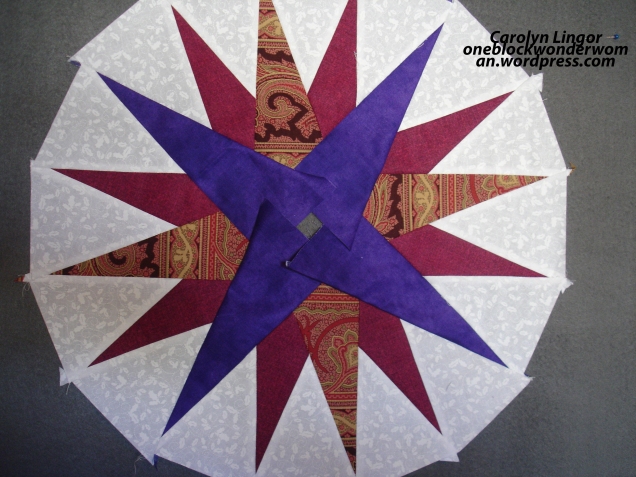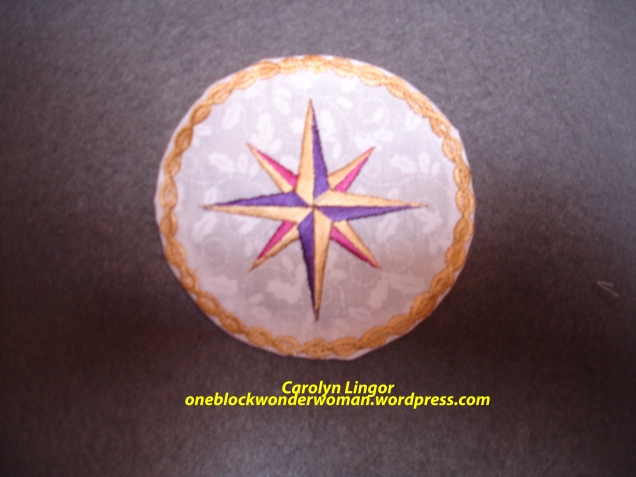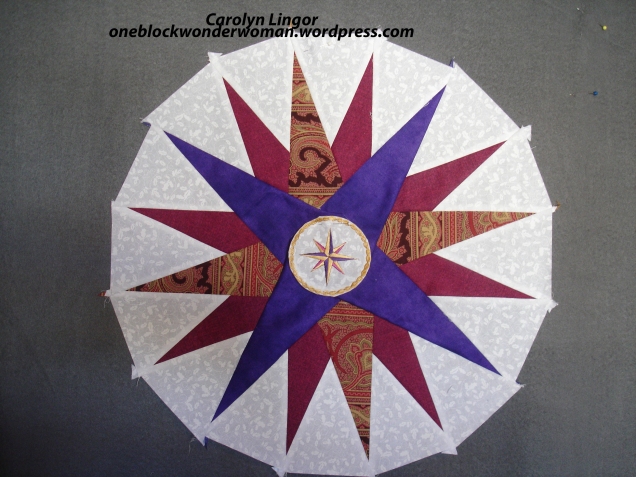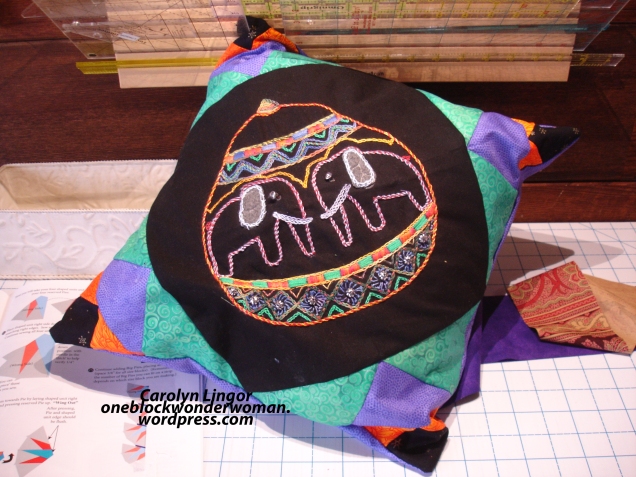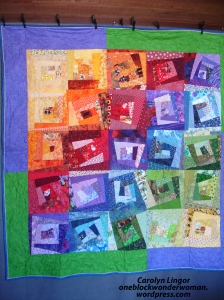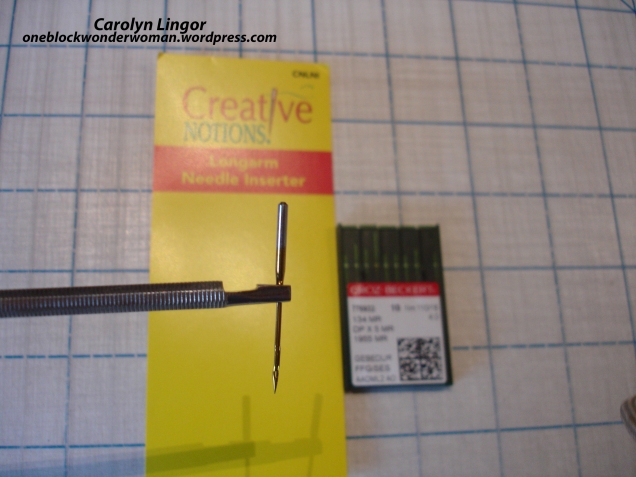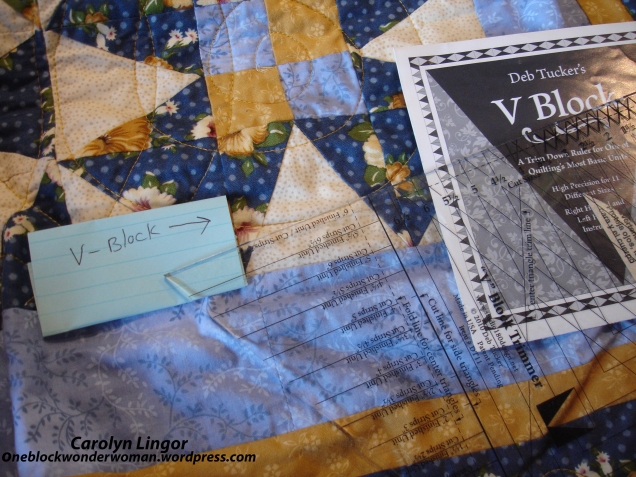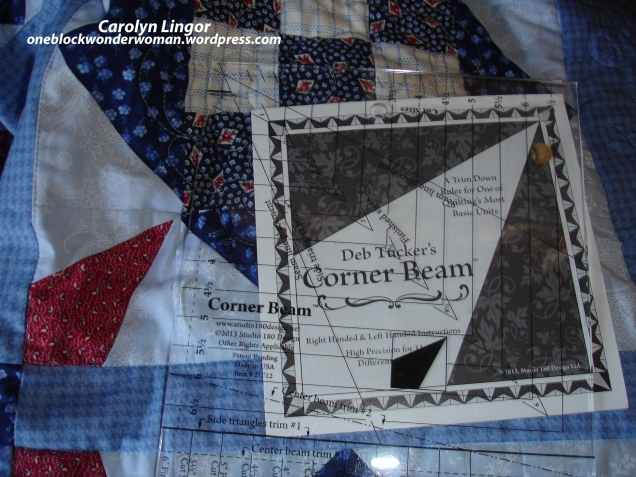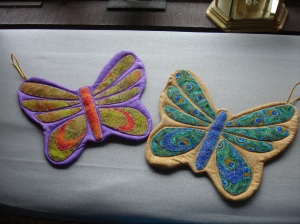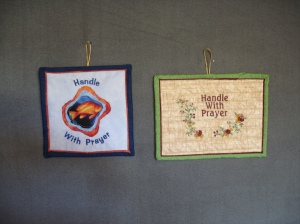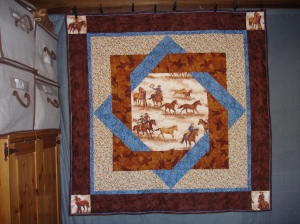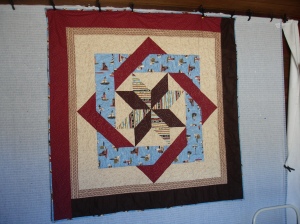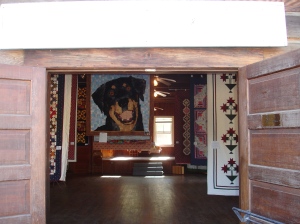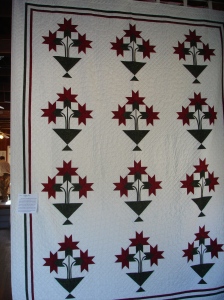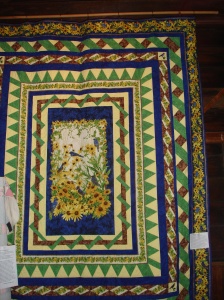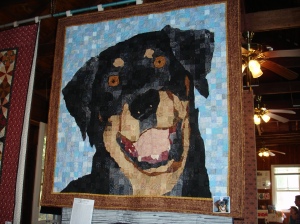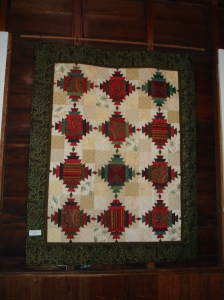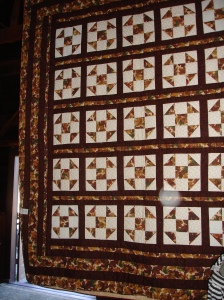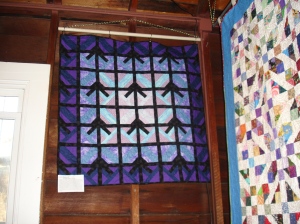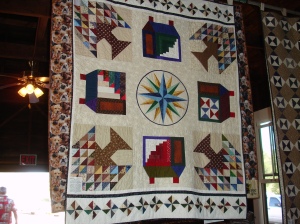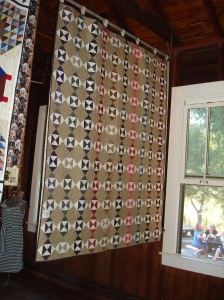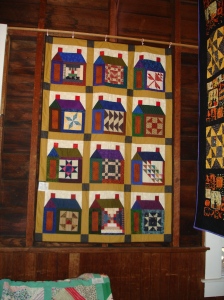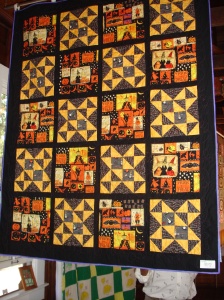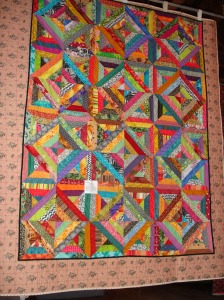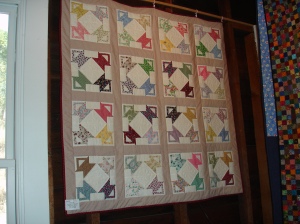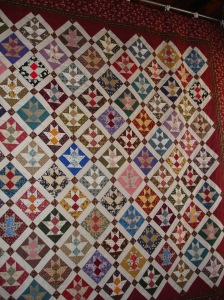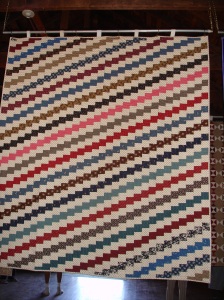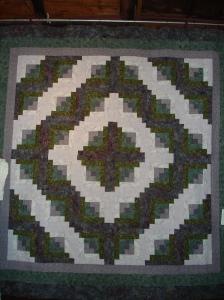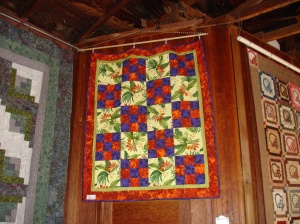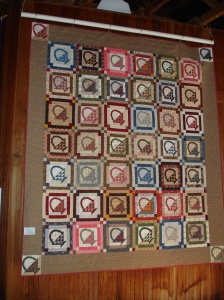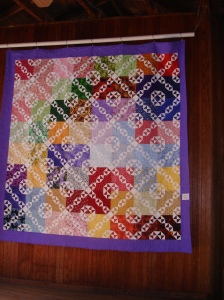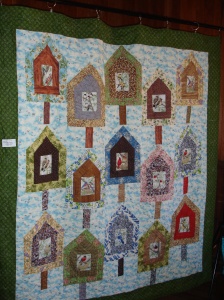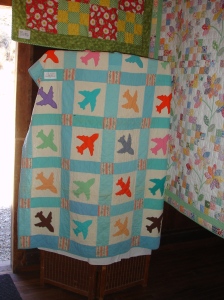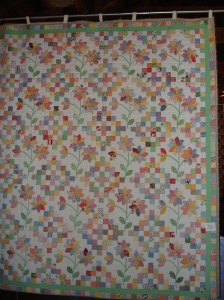I just finished putting a pieced border on this quilt. The pattern is a block of the month by Pat Sloan called Let’s Go Camping. As you can see, my pieced border fits perfectly all the way around and I didn’t have to spend a lot of time trying to find a way to put an oddball piece of fabric somewhere in the border to make it happen. Most of the time, I’ve found those coping, fudge or cheater pieces don’t look quite right. I kind of accidentally came across the solution I use now when I was doing a baby quilt a number of years ago. I’m sure someone else came up with this technique long before I did, but I’ve never seen it anywhere, so cannot give proper credit to anyone. This will be a wordy post, since I didn’t take any photos during the process, but I think you will find it worthwhile to read through to learn the process. Also keep in mind that I am mathematically challenged, so it is amazing that I figured this out. Quilting has definitely improved my math skills.
My goal for this quilt is to fit on our queen sized bed in our cab-over camper, so since the pattern made it come out as a square, I knew I would need to make some of the top and bottom borders larger than the side borders. I picked out a coordinating fabric, the footprints in the sand, to put as a “plain” border between the dark brown and the pieced border. The next thing I decided was how large I wanted my pieces in the pieced border to be. I chose a 4″ finished size square-in-a-square since the size of the quilt, both length and width, was close to being evenly divisible by 4. So I figured I would need about 15 pieces for the side borders and 14 for the top and bottom. Keep in mind you will need to make 4 extra pieces for the corners. I do not take into account these corner pieces in any of the measurements. That would just add more confusion to the whole process and it’s simple to just add on the corner pieces when you have everything else calculated out. Also notice that I haven’t yet even touched the “plain” border fabric.
I went ahead and assembled the required number of pieces for each edge of the quilt. The reason I assemble the pieced borders first is so that I don’t have to take into account all those seam allowances. I then measured the length of the completed pieced borders and the 4 edges of the quilt and immediately wrote the numbers down since they fall out of my brain almost immediately. All of the pieced borders were slightly larger than the edges of the quilt, just as I had planned, but since I needed to make the top and bottom plain border quite a bit larger to elongate the quilt and there was only a one-ish inch difference between the sides and top and bottom plain border width, I decided to add an extra piece on the pieced borders for the sides, and I also decided it would be best to work on the plain side borders first to get maximum length out of the top and bottom borders.
The plain side borders are adding width to the quilt, whereas the top and bottom plain borders are adding length. So the plain side borders have to be cut to accommodate the size of the top and bottom pieced borders. The plain top and bottom borders have to be cut to accommodate the size of the side pieced borders. It seems a little counter-intuitive at first, but it definitely works.
Here are my calculations for how much plain border I needed on the sides, which, as I said, I calculated first. The top and bottom of the quilt (width) measured 54.25 inches and the top and bottom pieced borders measured 59.25 inches. So that means I needed a total of 5 inches added to the sides of the quilt to fit the pieced borders. I divided that 5 inches by 2 so I have equal sized pieces on each side of the quilt which comes out to 2.5 inches. Then, very important, I added 1/2 inch for seam allowances to each piece. Don’t forget your seam allowances as I tend to do. So I knew I needed to add a 3 inch piece of plain border to each side of the quilt. I then measured the length of the quilt and cut the plain border that length. I then attached the plain side borders.
To make the plain top and bottom borders to add length, I again measured the length of the quilt, which was 56.5 inches, and then the length of the side pieced border strips, which was 67.5 inches. 67.5 minus 56.5 equals 11 inches, divided by 2 for the top and the bottom plain border, which equals 5.5 inches then adding in 1/2 inch on each piece for seam allowances, comes to 6 inches. So I cut my top and bottom pieces at 6 inches by the width of the quilt and attached them.
I then double checked my pieced borders and they fit like a dream along the plain borders. Then I added the four corner square-in-a-square pieces to the top and bottom borders, attached the side pieced borders first and then attached the top and bottom pieced borders with the added corner pieces. Everything came out perfectly as you can see.
I hope all that makes sense to everyone. One thing I wanted to add is that if something comes out to an oddball size, like one side of the quilt is 1/8th of an inch longer than the other side, I usually go with the slightly smaller measurement since there is usually a little leeway in a long pieced border.
I’m excited to finish up my camping quilt since we have a new to us camper with a bathroom!!! Hallelujah!!! Of course, I laid down the law last time we went camping. I said I would never go camping again until dear hubby bought me a camper with a bathroom after an unfortunate incident at 2 o’clock in the morning while broken down in a parking lot near Lake Shasta involving a small bucket and a yard sale purchased toilet seat on legs and a loss of dignity followed by a lot of yelling and the purchase of new pajamas the next day. I will leave the details up to your imagination. It’s funny now, but…..Just waiting for dear hubby to finish necessary modifications so that the camper will fit on our camper truck. The camper truck has what’s called a utility bed with tool boxes on the side that open out. This means that the bed of the truck is 4 feet wide all the way from the cab to the back with no wheel wells for a little corner of the bathroom to slide into. He has restructured that portion so it will fit, but now we are concerned that the little decorative apron thingies that slope down toward the back of the camper on the sides might interfere with the opening of the tool boxes, so they might have to get trimmed back. They are only “decorative” so shouldn’t be a problem. Also the restructured area in the bathroom needs to be re-fiberglassed since it is a wet room style shower.
The photo at the top doesn’t do a good job on some of the detail I put into the quilt. I had fun with my embroidery machine. The blocks each had a theme that they are supposed to represent. This one was “Things we take on a camping trip”. I stitched out one of dear hubby’s favorite fishing lures.
This one is “Things we do while camping”. You can probably tell which is dear hubby and which is me.
This one is themed “Stirring the pot”
And this one is “Things we camp in” Sure it’s a trailer, not a cab-over, but it’s cute and a design I had.
I also wanted to include a photo of a quilt I finished at the end of October. I had started it at my quilt guild’s retreat last November as you may recall. I am so happy with the way it turned out.
It is Linda Rink’s pattern called El Camino Real. Each block is dedicated to one of the early California missions and since we live in a replica of a mission, I thought it was very appropriate. I am calling it “Oh, My Stars!” You will notice I used my pieced border technique as described above to make this one fit. It took me about 9 hours to quilt this on Greta, my longarm machine. I also spent about 9 hours just staring at it trying to decide how to quilt each block. Here is some of the detail while it was still in the quilting process. If you click on the photo, it will enlarge so you can see better detail.
As you can see, I did a lot of ruler work, which is very time consuming.
I will most likely be spending Thanksgiving Day getting the camping quilt ready for quilting. We don’t have any nearby family and really don’t like to travel on holidays. I am also working on a baby quilt, experimenting with the trapunto technique for the first time. I love how it is coming out, but it is top secret for now. And I have done several quilts to donate to various causes and people in our community who have gone through some tough times. I will share some of that next time.
I have so much to be thankful for. No catastrophic wildfires in our immediate region this year, although several people we know have lost everything in the Paradise fire. It is raining. I have good health, a lovely home, precious friends and family, a fabulous church, the most wonderful husband in the world, and Jesus as my Savior. Hope you all have a wonderful and thankful holiday.













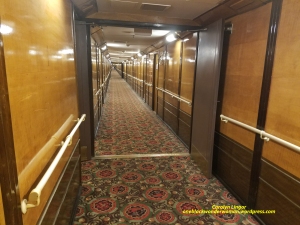




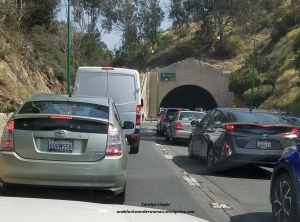







 The component on the left starts out similar to the piece on the right.
The component on the left starts out similar to the piece on the right. 




